

Suunto Blog
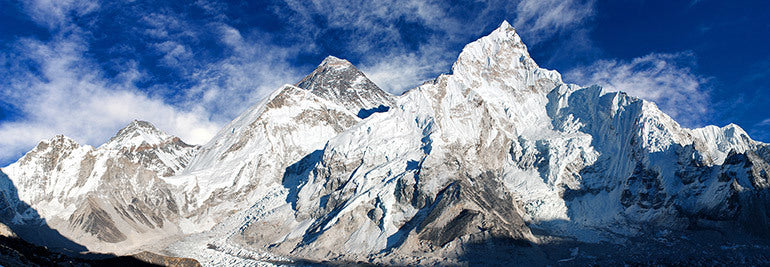
Kilian Jornet’s game plan for speed ascent of Everest
Suunto ambassador Kilian Jornet is acclimatizing in the Himalaya so he can attempt to set a fastest known time (FKT) record on the highest mountain in the world – Everest. We caught up with him and found out the game plan for his daring project.
It’s literally the “high point” of his Summits of My Life project – alpinist, runner and adventurer Kilian Jornet’s personal mission to set ascent and descent records on the most important mountains on the planet, culminating with Everest.
Denali, Mont Blanc, the Matterhorn, Aconcagua, Kilimanjaro – all have seen records fall to Kilian. But now he’s readying himself for the ultimate challenge.
He has been preparing for months. Intense training, sleeping nights at 4500 m in the European Alps, and now he's in Nepal, doing the same at 6000 m.
“The highest I have been is 7700 m,” Kilian says. “I was feeling good then, but there is a big difference after 8200 m and after 8500 m.
“It’s really important to be well acclimatized to around 6000 m. So I will spend many nights at around this altitude. And then it’s important I go to around 8000 m before the attempt.”
Kilian and his team has arrived in Kathmandu and is getting ready for the expedition.
Depending on how well he acclimatizes, Kilian expects to make a FKT (fastest known time) attempt around mid September. It also depends on weather and snow conditions.
The plan is a light and fast, alpine-style ascent. He will carry only what he can fit a backpack. To keep weight down, he and his team have designed light, but warm boots made for purpose. He won’t be fixing ropes or using supplementary oxygen on the ascent. He will attempt the ascent from the north side, via either Norton-couloir or Horbein-couloir depending on conditions.
Two previous ascents are in the back of Kilian’s mind as time references. The first is a speed record set by Italian mountaineer Hans Kammerlander in 1996. Hans climbed from Base Camp to the summit of Everest via the North Col in 17 hours. The second reference is an “unprecedented and unrepeated” ascent in 1986 by Swiss climbers Erhard Loretan and Jean Troillet. They climbed the North Face via the Hornbein-couloir in a single alpine-style push without oxygen, ropes, or tents and descended again – all in 43 hours.
“It’s good to know these times as a reference for pace at altitude,” Kilian says. “I will take this as knowledge and will see how far I can go."
“It’s a big mountain, and we have a long term perspective. We will try this year, but probably we will need to come again next year."
“You need to go for it so if conditions are good and if I’m feeling good, I should try. But it’s important to have the patience to wait for this good moment.”
READ MORE
This is how Kilian prepares for Everest
Main image: © Daniel Prudek/Shutterstock.com
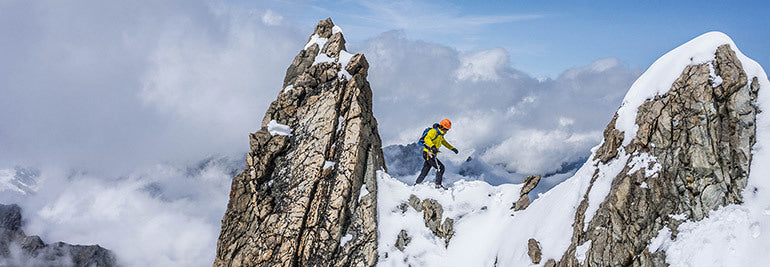
This is how Kilian Jornet prepares for Everest
This summer Kilian Jornet takes on the challenge of climbing Mount Everest, the final peak in his Summits of My Life project. Kilian will try to establish a record for the ascent and descent by a little-used route on the north face of the world’s highest mountain. To be ready for the challenge, he has spent a lot of time high in the Alps. Here are two of his training days on the Mont Blanc massif.
Physical training in the Alps: 6500 meters of climbing. (10.7.)
Kilian Jornet is taking on Everest with the purist and minimalist philosophy that is the trademark of the Alpine style. This means that, as with other challenges in the Summits of My Life project, he intends to complete the ascent in one go, without stopping at high-altitude camps. This is different from the classical Alpine approach but he has also acclimatizing himself in a different way. Kilian Jornet and his team intend to spend the last few weeks before they go to the Himalayas at a high altitude in the Alps.
Kilian’s training day high up on Mont Blanc Massif with over 3500 meters of climbing. (25.7.)
"It’s a new approach to acclimatization. Before we set off for the Himalayas we will have partly acclimatized having spent some days at altitude. This means we won’t have to wait so long to start when we arrive at the Everest base camp,” explains Jordi Tosas, Kilian’s teammate on Everest.
"This means we’ll be stronger when we begin the ascent. It can make you weaker if you spend several days acclimatizing yourself on the mountain. With this type of acclimatization we can begin the challenge with more energy and a better chance of success,” Kilian adds.
Main image: © Lymbus
Create Suunto Movies of your adventures with Suunto App.
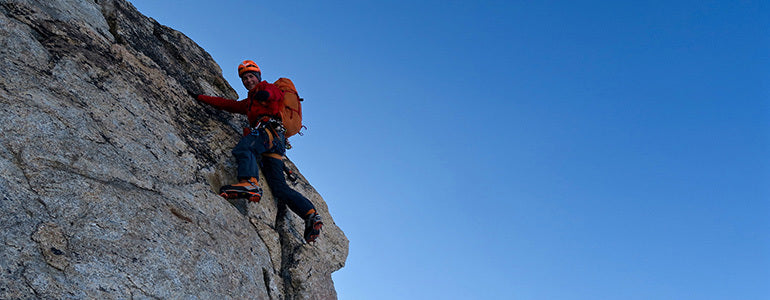
Finding the flow in the mountains
Top alpine climber Luka Lindič says learning to move fast and fluidly in the mountains has been the foundation of his success. © Aleš ČesenSlovenian climber Luka Lindič, 27, sees becoming a skilled alpinist as similar to building a house. With a strong foundation, the rest is possible. Without it, you’ll eventually run into difficulties. “It's really important to spend a lot of time in the mountains moving in all kinds of terrain, learning to be comfortable, because only then can you climb harder routes,” Luka says. “For me, building a foundation has been about climbing many, many relatively easy classic routes in the Slovenian mountains. “Many times I’ve realised I can do hard climbs, but if I don’t move a lot in easy terrain for a while then I lose this feeling of moving fluidly. You get stiff. You become slow. You don't have the flow to just move. I think it's really important to keep that.”
© Aleš ČesenHis approach of building the basics has clearly paid off. In 2015, he became one of the youngest people to win the prestigious Piolet d’Or Award, considered the “Oscars of alpinism”. Luka, and his two climbing partners Marko Prezelj and Aleš Česen won the award for their ascent of the north face of Hagshu (6515 m) in India.
Always coming back to relatively easy routes also reminds Luka why he fell in love with climbing in the first place. “I can’t deny that when I have a really ambitious project that’s on my limit it’s also stressful. If I would do only this, I would forget the feelings that originally brought me into climbing – the simple joy of being in the mountains.”
© Aleš ČesenLuka’s love of the mountains began as a child. Hiking is one of the biggest sports in Slovenia and his hiker parents took Luka whenever they went. He remembers walking past rock faces and looking up in wonder at the climbers scaling them.
It's really important to spend a lot of time in the mountains moving in all kinds of terrain, learning to be comfortable, because only then can you climb harder routes.
His curiosity grew and at 14 he joined his local climbing club and was fortunate to be mentored by some of Slovenia’s most experienced alpinists, particularly Marko Prezelj. They not only taught him the skills, but also brought him into the strong Slovenian climbing tradition.“We live in such a small place, a small community, and we meet day-to-day in crags because the distances are so small. That's one of the reasons we have so many good alpinists here. I’m very lucky.”
© Aleš ČesenOne of his toughest climbs was what was dubbed the “alpine ascent of the season” in 2014; the first free ascent of Rolling Stones on the north face of the Grandes Jorrasses, Mont Blanc massif. “Some people said it's wasn’t possible to do it in the style we did,” he says “But it was just a question of self-confidence.” This summer he is going to Pakistan and has climbing permits for Broad Peak (8051 m) and Gasherbrunn IV (7925 m). However, he wants to keep his plans open. “The reason is I want to be more free and not fix too much before I go,” he explains. “Many times when you are in big mountains you need to change your plans because of different factors. It's really important you feel free to do so, to play, to follow some crazy ideas, to think out of the box, and not be too fixed.”
Luka's climbing achievements:
Bhagirathi IV (Garhwal Himalaya, India) 6200 m, September 2009. Bhagirathi III (Garhwal Himalaya, India) 6546 m, September 2009. Bhagirathi II (Garhwal Himalaya, India) 6612 m, September 2009. Hagshu north face (Zanskar, Himalaya, India) 6657 m, September 2014.
Main image: © Aleš Česen
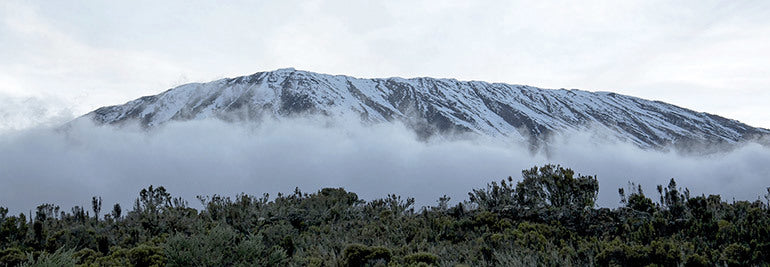
Mt. Kilimanjaro: More to Explore
“Mount Kilimanjaro is more than it’s famed snows, more than it’s iconic, statuesque crater that commands the landscape. It is more than the tallest “trekkable” mountain in the world. To hike Kilimanjaro is to be encapsulated into evolving ecosystems, from tropical rainforest to snow-covered peaks in a few days making for unique experience in our natural world,” describes adventurer Matt Mitchell.
There are seven established climbing routes on Kilimanjaro. To trek a different route to the summit is to live a separate and entirely unique experience. In search of true wilderness, we chose Rongai, the least trafficked route and the only one starting from the North, along the Kenyan border. It is the only trek that includes the entire spectrum of habitats in Kilimanjaro’s vast ecosystem, though you have to go out of your way to find it. After a two-hour drive from the park’s main gate, winding through hectic, dusty villages, we arrived at the trailhead. Our journey began in a wild, tropical rainforest, it was difficult to believe that in a few days we would be immersed in freezing cold and burning sun of arctic conditions.
Before we left for Tanzania we plotted the route to my Suunto Traverse GPS watch, helping us to navigate and identify POIs (camps and highlights) as well as and track our altitude and gain each day.
Kilimanjaro is a busy mountain year round on most routes, so when we found ourselves trekking alone we were surprised, and delighted. We felt like we had the mountain to ourselves, free to move at our pace and simply appreciate our surroundings. The mountain itself was pristine, even at camps debris or evidence of hikers was rarely seen.
Giant, jagged crevasses created by lava flows and home to streams from another time lay hidden behind wild and unwieldy bushes. Throughout the forest and heather our path was enveloped in thick rolling fog. Wide, sloping caves that were once shelter, now help to mark the trail.
Unlike routes from the south, clear views of Kibo are frequent above 3500 m on Rongai. While our previous days were filled with fog and mist, the greyness gave way to clear and intense days in the sun. Our nights got much colder above the clouds and we started to feel the thinning air as we moved toward the alpine desert. Our only company was a pair of white-necked ravens who followed us for two days and nights.
Kilimanjaro is not simply its dominant and easily identifiable volcanic cone (Kibo), with its graceful lines. In fact Kilimanjaro is made up of three volcanoes- Kibo, Mawenzi and Shira. Kibo remains dormant, the others extinct. As we traversed alpine desert in scorching 37 degree sun, the imposing, jagged edifice of Mawenzi appeared. Hans Meyer Peak is its highest point at 5149 m (third highest point in Africa) and is separated from Kibo by 6 km of baron desert known as ‘The Saddle.’
We arrived at Kibo Huts (4700 m) in the afternoon of our forth day, with a world already below us. We were paying for each moment at this altitude and higher, so at midnight under steady snowfall we climbed towards the stars. There was still a mountain above us, and all we could see were bobbing headlamps and utter darkness. We trudged across steep, scree switch-backs (up to 45 degree) for 5 hours, glancing only occasionally at the horizon for the slightest hint of the day to come. Breathing becomes more difficult with each step, relentlessly testing all faculties. Even simple recognition is not a given at this altitude. As we scrambled to the top of Gilman’s Point and beyond the grandeur of Kibo is startling, its glaciers, sheer cliffs and vast expanses are unforgettable.
There is nothing like feeling the day’s first light atop a mountain, invigorates your senses, and brings your body back to life. The streams of clouds and color and light made us feel like we could see all of Africa.
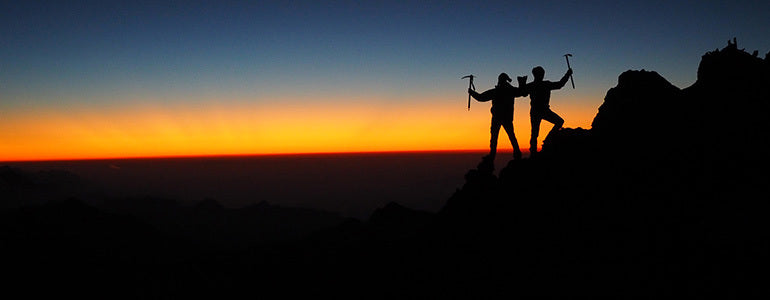
Meet the first guy scaling all the 7 summits – from sea level
High school teacher Dave Williams is attempting to become the first person to scale the highest summits of the seven continents by starting at sea level and running to each mountain.
Dave on his hike from the Black Sea to Mt Elbrus in Russia. © www.sea2summit7.comWhen Dave Williams isn’t teaching at a high school in Auckland, New Zealand, he’s doing one of two things: running or eating. “I run a half marathon in morning and a half marathon in the evening, which has made the necessary training feasible while working full time,” Dave says. “Keeping the weight on has been hard even though I eat eight meals a day.”
On the summit of Kilamanjaro. © www.sea2summit7.comDave has completed sea to summits on the highest mountains of four continents – Aconcagua, Kilimanjaro, Elbrus and Kosciuszko – and is about to set off to Alaska for a five-week expedition to make his attempt on Denali – the highest mountain in North America. Starting on April 19, he will run 350 km from Anchorage to the road end. “It will take five marathons to run to the road end, then a three day trek to the base of the glacier, then a nine day trek up the glacier to the base camp, then another two weeks to the summit,” he says. “One of the biggest challenges I've faced during preparation is to build the required fat and muscle stores while simultaneously increasing my fitness and running over 100 km per week. I predict I will lose up to 10 kg during the five weeks of adventuring.”
On the way to the summit of Aconcagua. © www.sea2summit7.comLater this year he will be heading to Antarctica to make a sea to summit attempt on Mt Vinson. He’s saving the best to last, however. In 2018 he will begin running from Kolkata, India, doing 32 marathons in 30 days, to Everest base camp and then climb the highest mountain in the world. “I enjoy climbing more than the running,” he says. “Running is more repetitive. “When I start running I know I’ve got the best to look forward to. The finale is the climb.” The 30-year-old outdoor education teacher began his Sea2Summit7 project in 2013 after two friends committed suicide due to long battles with depression. The loss got him thinking about depression and what he could do to help. “I had an epiphany while doing a sea to summit adventure in New Zealand,” Dave says. “I thought I could do same thing on the 7 Summits and raise money for the Mental Health Foundation.”
Success at last! © www.sea2summit7.comHe’s raised $5,400USD so far and, incredibly, has paid for most of the project out of his own pocket, investing $50,000NZD ($34,000USD) until now. The first mountain of the project, Aconcagua, was the most difficult. He failed twice. On the first attempt in July 2014, a storm hit on his summit attempt and climbers he had met earlier died on the mountain. On the second attempt his body gave out on the climb and he had to call it off. Finally, in January 2016, everything came together and he summited Aconcagua. “The thing that always keeps me going is receiving personal messages from people who have been following the project and who say I’ve inspired them to get off the couch,” he says. Dave hopes he has to run to Denali only the once. “Sea2Summit7 is all about never giving up and calling on friends to help when you are feeling fragile," Dave says. “This time I have an awesome expedition team of five who will be fulfilling specific roles along this journey so it is feasible and safe.”
World Vertical Week 2016 Big Data
It was a race to the top! National and tribal pride was on the line as people around the world tried to prove their country or sport is king of the hill. World Vertical Week 2016 has closed and the stats are in so it's time to see who came out on top!
WHICH COUNTRY CLIMBS THE MOST?
Surely alpine nations have an unfair advantage? Mostly, yes, but not always. There were a couple of surprises! This visual shows the top 10 countries for average ascents in human powered outdoor activities.
Congratulations Switzerland, Austria and Slovenia!
WHO CLIMBS THE MOST?
Trail runners, cyclists and trekkers were humbled as – maybe unsuprisingly – ski touring and mountaineering led the highest average ascents. As a consolation, remember there would be very different results in summer!
Skiers climbed the most
NUMBER ONE CLIMBERS IN THE WORLD
The Swiss are on top again and nearly breaking the thousand-meter mark in both ski touring and mountaineering. The other two countries with two first places were more surprising: Colombia was on top in running and cycling and Hong Kong topped the chart in both trail running and trekking.
The toughest mountain goats come from the Switzerland.
TOP COUNTRIES IN DIFFERENT ACTIVITIES
And to give you even more to speculate here are the top five countries in the activities mentioned above.
Top 5 in ski touring
SWITZERLAND 996 m
SLOVENIA 941 m
FRANCE 908 m
ITALY 895 m
SLOVAKIA 885 m
Top 5 in mountaineering
SWITZERLAND 971 m
FRANCE 881 m
ITALY 798 m
AUSTRIA 710 m
GERMANY 696 m
Top 5 in trail running
HONG KONG 890 m
CHINA 684 m
ITALY 640 m
JAPAN 553 m
SLOVENIA 543 m
Top 5 in trekking
HONG KONG 705 m
SOUTH AFRICA 519 m
MALAYSIA 428 m
SLOVENIA 424 m
NETHERLANDS 420 m
Top 5 in snow shoeing
ITALY 558 m
AUSTRIA 488 m
GERMANY 428 m
SWITZERLAND 426 m
FRANCE 416 m
Top 5 in mountain biking
PORTUGAL 533 m
ITALY 518 m
SPAIN 479 m
SOUTH AFRICA 452 m
SWITZERLAND 400 m
Top 5 in cycling
COLOMBIA 481m
SOUTH AFRICA 409 m
ANDORRA 403 m
SLOVENIA 396 m
SPAIN 391 m
Top 5 in cross country skiing
SPAIN 367m
CZECH REPUBLIC 351m
FRANCE 298m
NORWAY 261m
JAPAN 248m
Top 5 in running
COLOMBIA 193 m
SLOVENIA 164 m
ANDORRA 148 m
HONG KONG 140 m
PORTUGAL 140 m
READ MORE
7 TIPS TO ACCELERATING YOUR UPHILL SPEED
PERFORMING YOUR BEST WITH VERTICAL SPEED
KIMBERLY, DAVID AND KYLE ARE THE VERTICAL WEEK PHOTO CONTEST WINNERS!














































































